KY-037 High Sensitivity Sound Detection Module
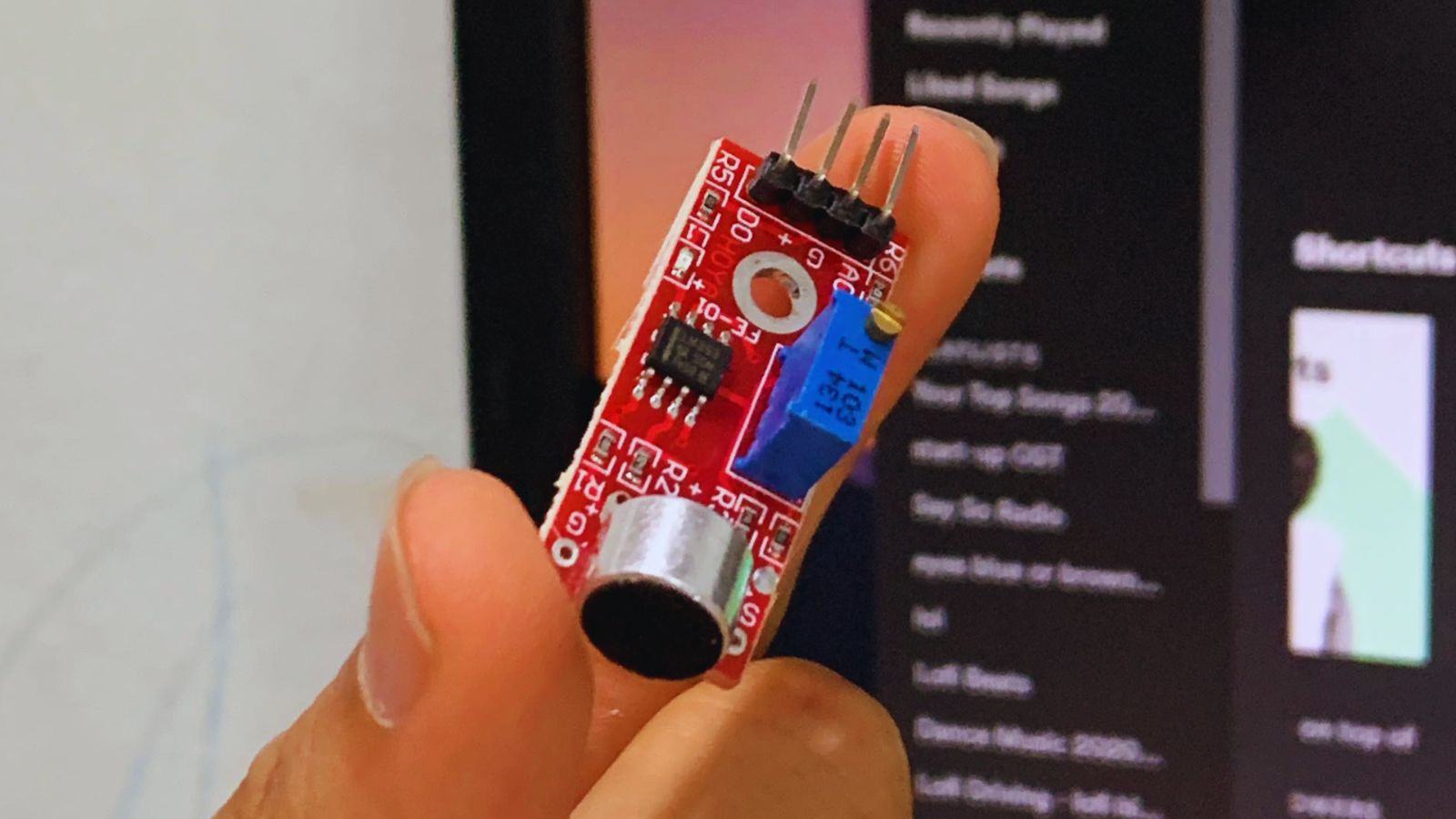
The KY-037 high sensitivity sound detection module is an analog/digital sensor that uses a condenser microphone to observe changes in environment noise. Generally used to detect sound above certain levels. It has a potentiometer to set the noise detection threshold.
The digital output provides a HIGH signal when sound above the threshold is detected. The analog output shows values representing the noise levels detected by the condenser microphone, the values are relative to the provided voltage and potentiometer position, making it difficult to reconstruct the audio from the obtained values.
This module is compatible with popular microcontroller platforms like Arduino, ESP32, ESP8266, and Raspberry Pi.
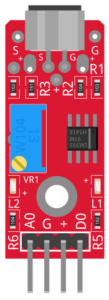
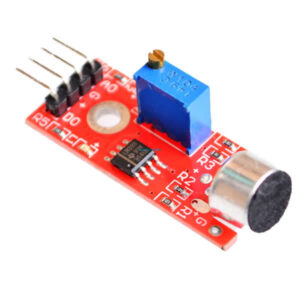
KY-037 Specifications
This module has a CMA-6542PF electret condenser microphone, an LM393 differential comparator to control the digital output, a 3296W potentiometer to adjust the detection threshold, 6 resistors, 2 LEDs and 4 male header pins. The module features analog and digital outputs.
| Operating voltage | 3.3V ~ 5.5V |
| Microphone sensitivity | -42 ±3 db |
| Current consumption | ~0.5mA |
| Board Dimensions | 15mm x 36mm [0.6in x 1.4in] |
Connection Diagram
Connect the module’s analog output (A0) to pin A0 on the Arduino, and the digital output (D0) to pin 7.
Connect the module’s power pin (+) and ground (G) to 5V and GND respectively.
| KY-037 | Arduino |
|---|---|
| A0 | Pin A0 |
| G | GND |
| + | 5V |
| D0 | Pin 7 |
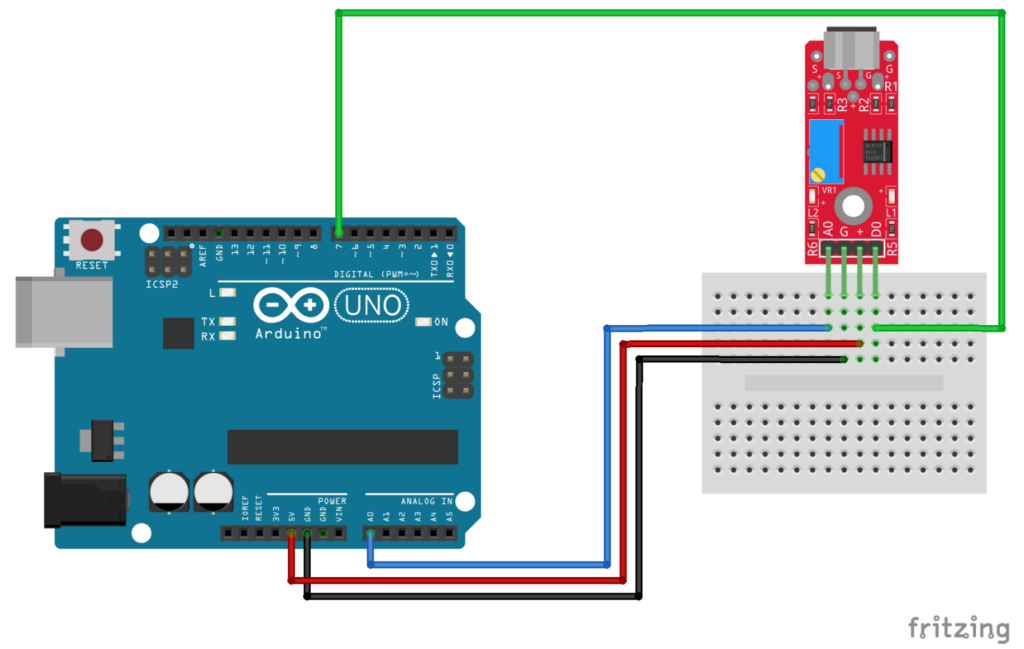
KY-037 Arduino Code
In the following Arduino sketch, we’ll measure the environment noise levels using the analog output of the module.
Calibrate the module’s detection threshold using the potentiometer. Turn it clockwise to increase detection sensitivity, or turn it counter-clockwise to decrease detection sensitivity.
If the module’s L2 LED is on, the noise levels are above the threshold and you should decrease the sensitivity. If the L2 LED is off, the noise level is below the threshold and you should increase the sensitivity. Turn the potentiometer to find the exact point where the LED changes its state.
Now that the detection threshold is calibrated, the digital output will activate the Arduino’s LED on Pin 13 when noise is detected. The analog output will show values relative to the supplied voltage and potentiometer position.
int digitalPin = 7; // KY-037 digital interface
int analogPin = A0; // KY-037 analog interface
int ledPin = 13; // Arduino LED pin
int digitalVal; // digital readings
int analogVal; // analog readings
void setup()
{
pinMode(digitalPin,INPUT);
pinMode(analogPin, INPUT);
pinMode(ledPin,OUTPUT);
Serial.begin(9600);
}
void loop()
{
// Read the digital inteface
digitalVal = digitalRead(digitalPin);
if(digitalVal == HIGH)
{
digitalWrite(ledPin, HIGH); // Turn ON Arduino's LED
}
else
{
digitalWrite(ledPin, LOW); // Turn OFF Arduino's LED
}
// Read analog interface
analogVal = analogRead(analogPin);
// Print analog value to serial
Serial.println(analogVal);
}Use Tools > Serial Plotter on the Arduino IDE to visualize the values on the analog output.
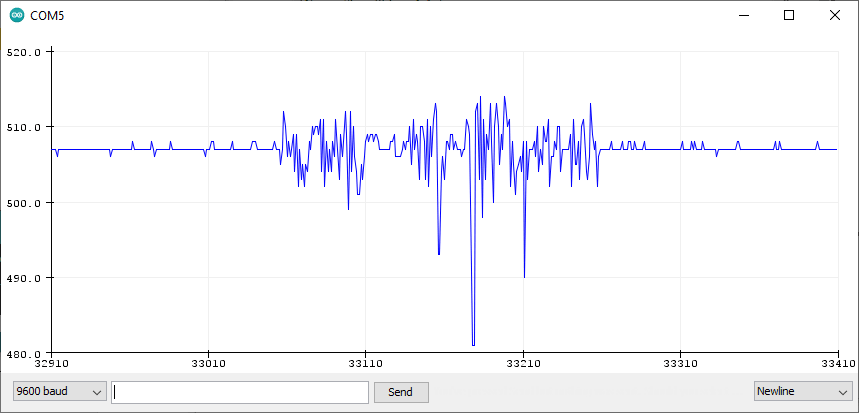
❓ Frequently Asked Questions (FAQ)
1. What is the KY-037 High Sensitivity Sound Detection Module?
The KY-037 is a sound sensor module that detects ambient sound or noise levels using a built-in microphone and analog/digital output signals, ideal for Arduino and other microcontroller projects.
2. Where can I buy the KY-037 sound sensor module in Sri Lanka?
You can purchase the KY-037 module from local electronics shops, online platforms like Daraz.lk, and Sri Lankan Arduino stores like Thingerbits, Techkatha, or EmbeddedLk.
3. How does the KY-037 sound sensor work?
It detects sound via an electret microphone, amplifies it, and provides both analog (A0) and digital (D0) outputs. You can adjust the sensitivity using the onboard potentiometer.
4. Is the KY-037 compatible with Arduino boards?
Yes, the KY-037 is fully compatible with Arduino Uno, Mega, Nano, and similar development boards used in Sri Lanka and globally.
5. What is the difference between KY-037 and KY-038?
KY-037 has a higher sensitivity compared to KY-038, making it more suitable for detecting faint sounds or low-volume audio signals.
6. What are the typical applications of the KY-037 in Sri Lanka?
Common applications include voice-activated projects, sound-based alarms, baby monitors, smart home automation, and noise-level indicators in classrooms or offices.
7. How do I connect the KY-037 to an Arduino in a project?
Connect VCC to 5V, GND to GND, A0 to an analog pin, and D0 to a digital pin on your Arduino board. Use simple code to read sound levels and trigger outputs.
8. Does the KY-037 work with Raspberry Pi or ESP32 boards in Sri Lanka?
Yes, the KY-037 can be used with Raspberry Pi, ESP32, or NodeMCU boards, commonly used in Sri Lankan IoT projects, though additional configuration might be needed.
9. Can the KY-037 detect specific sounds like claps or speech?
The KY-037 detects general sound levels but does not differentiate between sound types. For speech or specific sound recognition, advanced modules or software are required.
10. How can I increase or decrease the sensor’s sensitivity?
Use the blue potentiometer (knob) on the module to adjust the sound sensitivity according to your project requirements.
11. What is the price of the KY-037 sound sensor in Sri Lanka?
Prices typically range from LKR 300 to LKR 600, depending on the supplier and location. Discounts may be available for bulk purchases.
12. Is there a warranty for KY-037 modules purchased in Sri Lanka?
Warranty availability depends on the seller. Reputed sellers like Thingerbits or Livezen-affiliated stores may offer return policies or limited warranties.
13. Can KY-037 be used in school or university projects in Sri Lanka?
Yes, KY-037 is commonly used in educational projects for students studying electronics, robotics, and embedded systems in Sri Lankan schools and universities.
14. How do I know if my KY-037 module is working?
The onboard LED lights up when sound exceeds the threshold. You can also view real-time values via Arduino Serial Monitor or LED output control.

